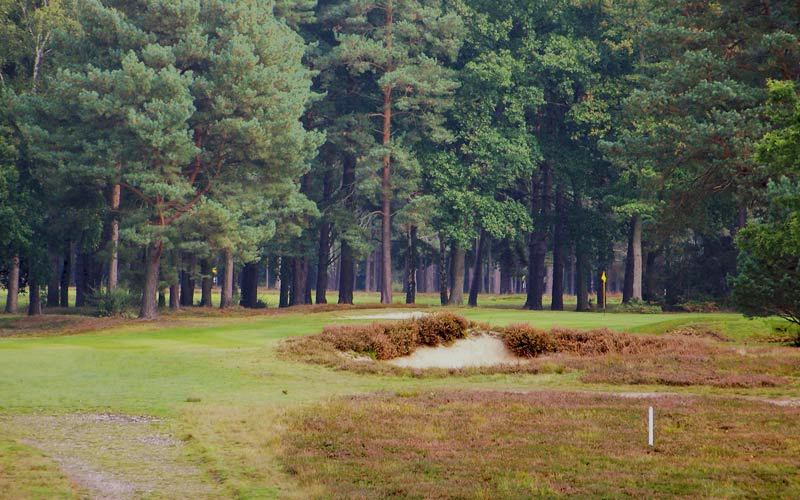Woking Golf Club
Surrey, England
‘…the best and pleasantest place to play golf that I have ever known.’ Bernard Darwin
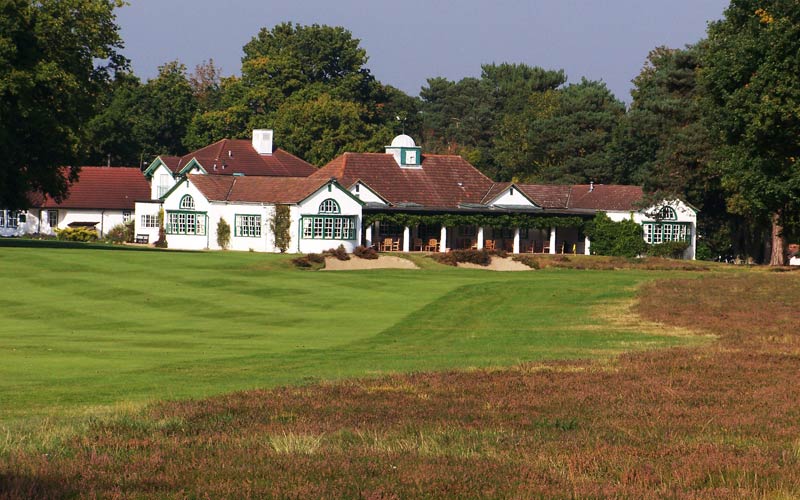
For over a century, Woking has furthered golf course architecture like few other clubs.
Tom Simpson and H.N. Wethered in The Architectural Side of Golf said they would select Woking as the course they would choose to play the rest of their lives if they were condemned to but one choice. Is it because Woking possesses one stunning hole after another? No, not really. In fact, Tom Simpson and Wethered reckoned the second hole to perhaps be the sole hole that ‘could be termed of really outstanding merit.’ And yet, they selected this course to be the one they would play for the rest of their lives? What does that say about the misguided attempts of modern architects today who try to build eighteen signature holes?!
Several of most influential chroniclers of the game also fell under the charm of Woking, including members Bernard Darwin and John Low as well as Sir Peter Allen. What then draws such knowledgeable men to Woking?
Located one hour south of London, Woking is in fact the first heathland course ever built with play having commenced here in 1893, well before Walton Heath and Sunningdale for instance. Tom Dunn was the original architect, however he was not known for his bunkering or imaginative green complexes. Although little of his work remains untouched at Woking (or throughout the United Kingdom for that matter), Dunn does in fact deserve the primary credit for today’s routing. Nonetheless, the student of architecture isn’t going to Woking for the routing. Rather, the changes undertaken by member Stuart Paton over nearly a forty year (!) period are what make Woking full of appeal.
Paton left a legacy of noteworthy holes; there is not an indifferent one among them. The short first and eighteenth are made by their cleverly contoured greens. The par five fifteenth is the longest hole on the course and is straightaway. Instead of being a slog, the imaginatively contoured green generates appeal well back in the fairway. Though Paton only considered himself a member and never a golf course architect, his work had a profound influence. All the great British architects in the first half of the twentieth century came to Woking, many numerous times, to see what the fuss was about. Sir Guy Campbell wrote, ‘I never cease admiring the genius which created these holes, especially when one remembers that they were made long before the southern golfer had been educated up to this kind of thing.’ One only wonders what architects like Harry Colt, Alister Mackenzie, S. V. Hotchkin, C.K. Hutchison, Hugh Alison, J.F. Abercromby, Herbert Fowler, and John Morrison took away from their visits to Woking.
Holes to Note
Second hole, 220 yards; The long shot across a valley was thought by Tom Simpson and Wethered to be of ‘really outstanding merit.’ Little has changed since those comments were made nearly eighty years ago. A new back tee means that a long iron or wood is still required for most to reach the green. In addition, this hole re-gained its open look from decades gone by as two oaks were removed from left of the green in 2006.
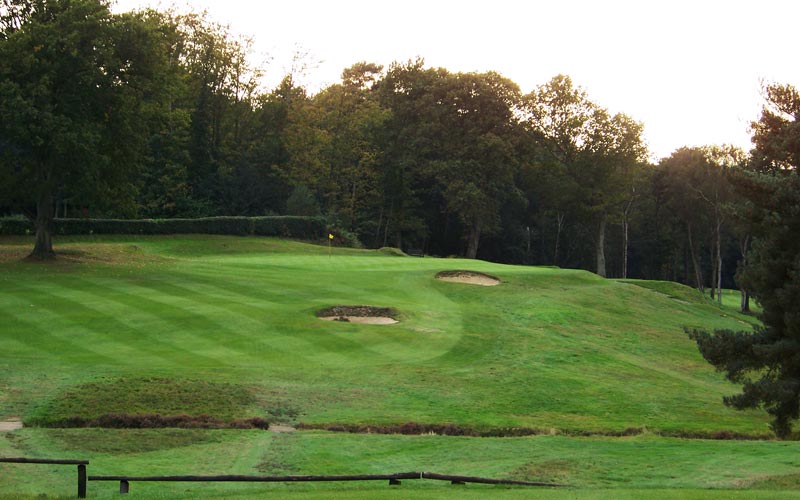
Chasing after right hole locations is an act of madness as the second green seemingly falls away down the hillside.
Third hole, 445 yards; Woking has forty-seven bunkers. The broad view held at the Club is that this is a heathland course and the natural roll of the land and its heath should dictate much of the course’s strategy. A.W. Tillinghast preached long and hard against over-bunkering and he would have been very pleased should he have ever paid a visit here as Woking‘s bunkers are never superfluous and are deployed to maximum benefit. A great example is the solitary bunker at the front right of the third green – it dictates the play for the hole and makes the approach shot to the contoured green a real challenge under all circumstances. This comment rings especially true based on the new tee built in 2007 that added 32 yards in length. Once again, mid to long irons are called for on the approach and great thought should be given to how to use the ground around the green as one’s friend. Interestingly enough, though the third doglegs to the right, a draw from the tee (for added to distance and to get to a more level stance) and a drawn approach (kicking the ball onto the green from right of the bunker) are often times the best way to play the hole.
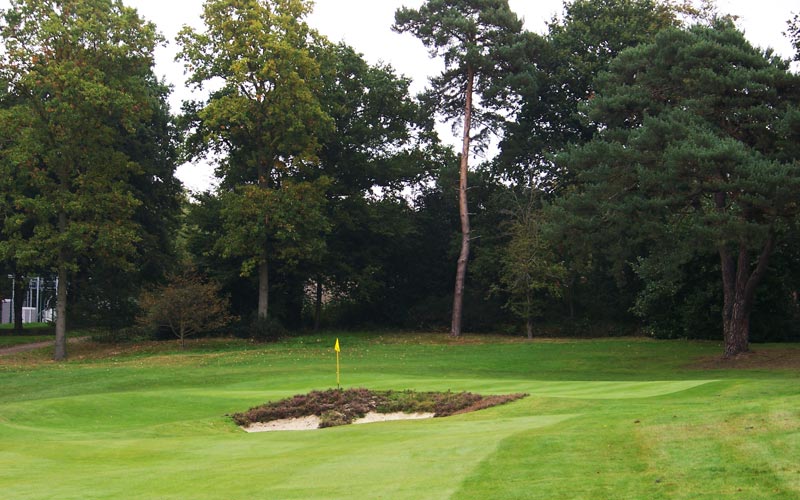
With the third green located in a natural bowl, this solitary bunker is all that was needed to govern play.
Fourth hole, 350 yards; Originally, Dunn laid out an ordinary straight-ish short par four. Then one day, inspired by the Principal’s Nose at the sixteenth hole on The Old Course at St. Andrews and without consulting with the Board, Paton placed two bunkers smack in the left middle of the fairway right where drives liked to go. The golfer now had the option to play safe on his tee shot, going left of this bunker complex. However, he then faced a ticklish approach over the left greenside bunker. Conversely, he could elect to drive aggressively between the bunkers and the out of bounds train line and leave himself a straightforward pitch. Paton’s bunkers created quite a furor in their day. Tom Simpson, on a stormy day, went out and studied the fourth hole for nearly the entire day, so engrossed was he by the hole’s strategic merit. The golf world owes much to that day as Tom Simpson became inspired enough to become a first rate architect in his own right. He left many outstanding designs behind, including Ballybunion and Morfontaine. Although Paton’s fairway bunkers garner the attention at this most famous of inland holes, note needs to be paid to what he did greenside. His front left bunker combined with the green that runs from front left to back right are essential compliments to the Principal’s Nose as without them, the hole wouldn’t possess near the same strategic merit.
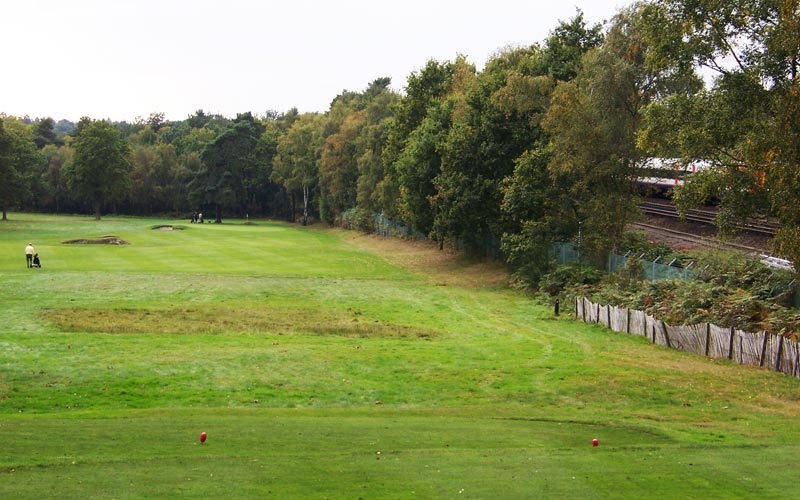
Paton’s famous bunkers are in the left middle of the fairway. Steady nerves are required off the tee as the train speeds past.
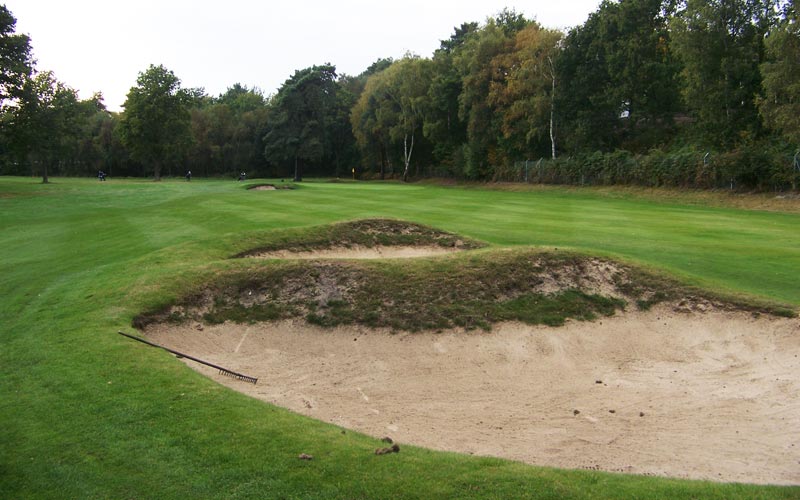
Built in 1901, Paton’s bunkers in the fairway of the fourth have had arguably as much influence as any bunkers ever built by man.
Sixth hole, 420 yards; From 2004 to 2007, Woking added over 200 yards in length to where the course now measures nearly 6,550 yards against a tight par of 70. Forty of those yards came with a new back tee on this hole. From its elevated perch, golfers delight in seeing their tee ball sail into the far distance. Combined with the new tee, three bunkers were added down the right, pinching in just where a slightly pushed drive might finish. Nonetheless, the real challenge of the hole still lies ahead, as a stream was put to particularly good use.

The new tee gives the golfer a commanding view down the sixth hole, showing both the new bunkers along the right as well as the fine diagonal use of a stream fronting the green.
Eighth hole, 455 yards; One of the great holes in heathland golf, the author believes Tom Simpson and Wethered would be mightily impressed with today’s version and would add this hole as having ‘outstanding merit.’
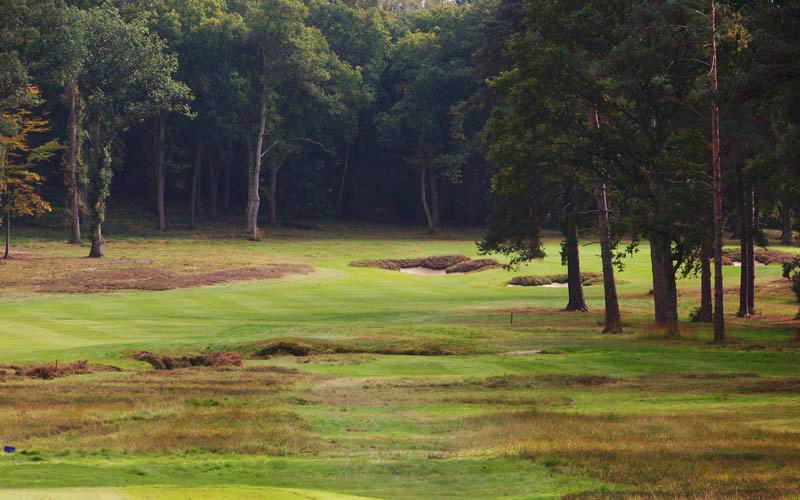
As seen from the tee, the drive at the eighth needs to clear the same brook that fronts the sixth green while staying far enough to the left not to be blocked by the pines on the inside of the dogleg.
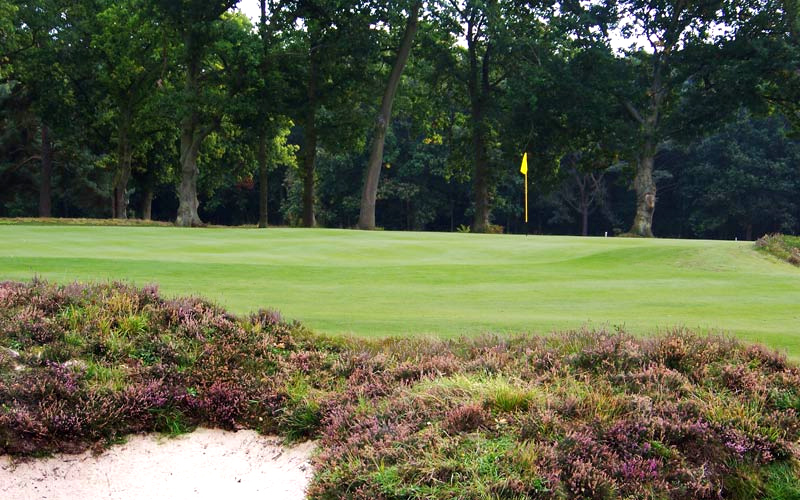
The approach to the eighth is often with a long iron or wood and must avoid the four heath-laden bunkers around the imaginatively contoured crowned green.
Woking Golf Club
Surrey, England
Eleventh hole, 385 yards; The next three holes parallel one another and are all par fours. Though that may seem potentially mundane, nothing is further from the truth. Each hole is unique unto itself, thanks to how the holes fall differently across several natural depressions as well as each hole’s distinctive green.
Twelfth hole, 415 yards; This hole embodies one of the classic design features of the Golden Age architects, namely the fairway is quite broad with the challenge stiffening at the green. Off the tee, the twelfth feels like a true heath hole as the fairway is so lined on both sides. The fairway’s generous width encourages a bold, free swing. Hopefully, the golfer can reach the crest of the hill as a full view of the green is quite helpful.

The twelfth features a wonderfully conceived green site that flows easily off the hillside.
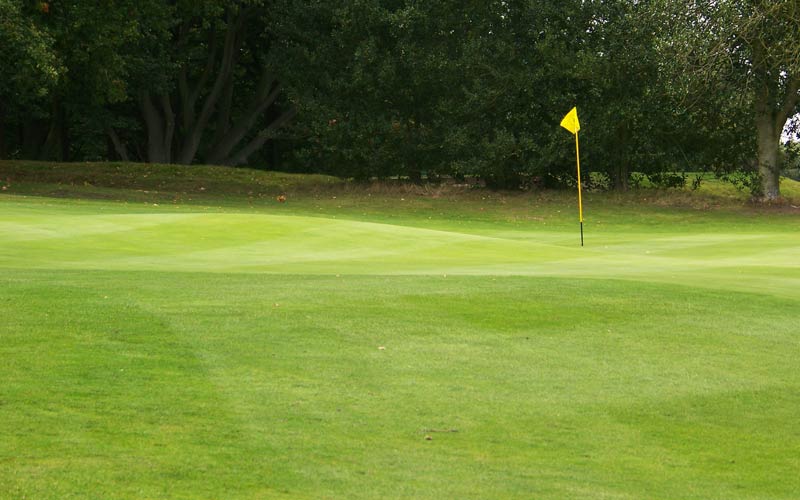
Closer inspection shows the green is full of challenge, featuring a three foot drop from the green’s left to right side.
Thirteenth hole, 430 yards; An appealing heathland hole from the tee, this hole is turned into a standoutone by virtue of its green complex. Referred to as ‘mountainous’ by Darwin, the green perhaps more closely resembles a rolling sea, with its high left and right halves divided by a lower plateau.This one-of-a-kind green is a marvel; more course architects should study it.

The thirteenth green’s gully can be seen in this view from behind the green.
Fourteenth hole, 540 yards; This hole possesses a feature rarely seen in modern courses, namely a boldly contoured green located a mere seven paces from the clubhouse verandah. Hitting the dreaded half wedge approach shot and putting out under the watchful eye of the members is unnerving. Needless to say, the clubhouse and surrounds are an integral part of the course. Sadly, due to the litigious society in which we now live, the roof was recently made out of bounds and members can no longer climb up a ladder to play their third shot!

A murmur or two from the porch only makes the man who just three putted feel worse.
Seventeenth hole, 435 yards; A much admired long hole, the seventeenth is understated golf course design at its finest. Several of the most vexing shots at The Old Course at St. Andrews come from the fact that many of its greens slope from front to back. Same applies here. When Paton combined a right front bunker with a green that slopes away and to the left, right hole locations have stood the test of time for being among the most difficult on the course. After carding a ‘five’, the golfer might well reflect on the wisdom of Sir Guy Campbell’s summation, paid after one of his visits here, that ‘Once again, Woking proved itself the most subtle of all inland courses.’

The shoulder of the bunker in the foreground flows into the green, propelling balls along the front to back sloping green.
Eighteenth hole, 350 yards; Pete Dye once remarked, ‘Show me a clubhouse with a pretty long view and I’ll show you a tough finishing hole with a long uphill second shot.’ Ignoring the message sent by such courses as The Old Course at St. Andrews, Prestwick, and North Berwick, far too many modern courses end on a formulaic hard long par four. Owners would be better served to study a hole like the eighteenth at Woking, one that allows the golfer to finish on a positive, up-beat note. At 350 yards, the hole is within range of all golfers. The bold interior green contours are such that the club can make getting a ‘3’ a real test for even the best. For the rest of us, we are pleased with our par, and the prospect of perhaps playing a few more holes.
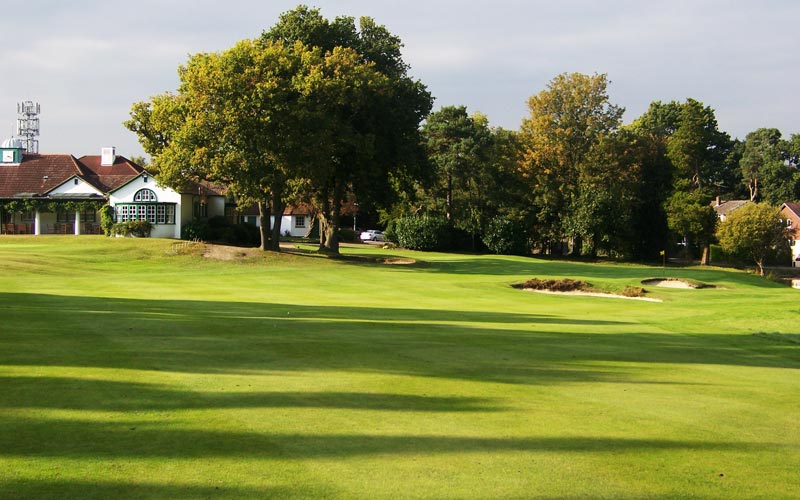
With Woking’s famous clubhouse to the left, the eighteenth bends to the right and calls for a short iron to a cleverly contoured green that slopes from left to right toward a pond.
Other virtues of Woking include that it is primarily a two ball course; early in the century it was noted that four ball matches tended ‘to keep the green waiting.’ Also, in recent years, the intelligent tree clearing program has helped enormously to increase sunlight and air throughout the course, thus successfully re-stimulating the heather to grow. Remaining true to its roots, Woking is once again taking on the appearance and playing characteristics of a genuine heathland course.
In the monologue by way to preface of The Architectural Side of Golf, J.C. Squire notes that Simpson ‘surveys his acreage of land, and says to himself, ‘How can I lay out a course of eighteen holes with these desiderata in view: that 1. Every hole shall be interesting 2. The maximum of variety shall be provided 3. The natural beauty of the country shall be impaired as little as possible 4. A premium shall be put upon good golf, and 5. The course shall be equally interesting and amusing to the first-rate and second-rate golfer.’ These five cornerstones form a great design philosophy to this very day and it is worth noting that Simpson developed it by studying Paton’s work at Woking. It is also worth noting that Simpson’s courses typically feature one of two greens that slope from front to back, another design attribute that he learned at Woking.
Some of the most influential writers of the time, including members Bernard Darwin and John Low, were quick to praise Paton’s work as he went along. Their written word helped attract all the more visitors and students of golf course architecture to the course. Even before the term ‘golf course architect’ was coined, Woking had become a think-tank on advanced design principles. At the turn of the twentieth century, man was quite awkward at adding strategic hazards to inland courses and the work done at Woking helped change all that. Overstating Woking’s influence on the evolution of golf course architecture is impossible.
The End


